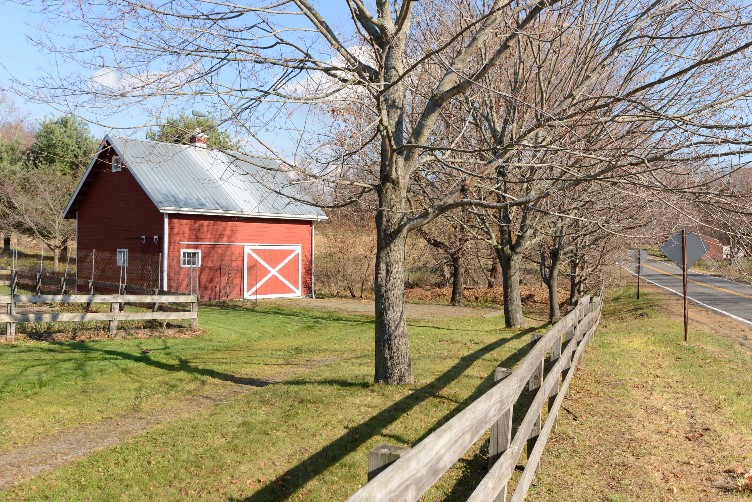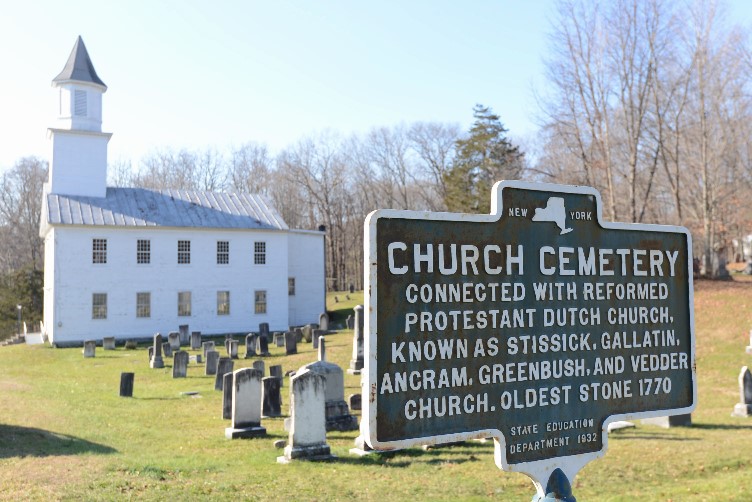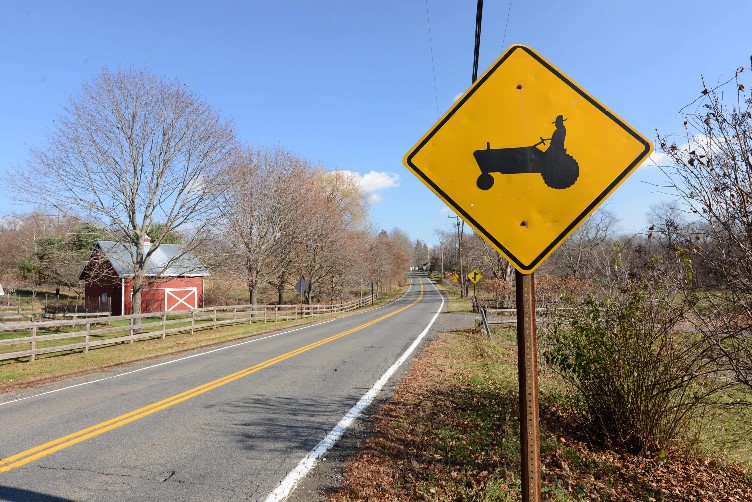The town we know today as the Town of Gallatin has a long history that goes back to the early Dutch and British settlers.
Gallatin was formed when Ancram named after the family home of Robert Livingston was divided into two parts. The eastern area was named Gallatin after Albert Gallatin, who was Secretary of the Treasury from 1761 to 1849.
Located two hours north of New York City and one hour south of Albany, the Town of Gallatin has a population of 1,600 people. A rural community with historic homes, undulating farms and woodland, Gallatin comprises several settlements. Taghkanic State Park is situated within the Town’s borders.

The highest point in the Town is Mattashuck Hill, also known as Signal Rock (elevation 1104 feet) south of Lake Taghkanic, which was used by native Mahicans for fires and smoke signals that could be seen for many miles.
The actual date of the first European settlement in what is now Gallatin is thought to have been in the early 1700’s. The standard history of Columbia County (1878) names Hans Dings, a Palantine German, as the first settler. Tradition has it that Hans Dings was following the course of Roeliff Jansen Kill when he came across a native American in a lovely glade who invited Dings to settle there. The area of this settlement is now called Silvernails.
The Dings family cemetery, located off Silvernails Road, is the oldest cemetery in Gallatin, dating from before 1748. At one time there was a railroad station, a post office and a grist mill at Silvernails. The railroad station sign was salvaged and hangs on a barn near the Roe-Jan Farm on Silvernails Road.

The only church now standing in the town is the Gallatin Reformed Church, on County Route 7. It was established in 1748 as the Dutch Reformed Protestant Church, with a simple Dutch-style wooden building. In 1823 the old church building was condemned and a new one constructed just north of it. In 1872 an addition was added to house the pipe organ, and there were further renovations in 1874.
Among the other early settlements comprising the Town of Gallatin is Snyderville. This hamlet through the years has borne the names of various families who lived there not only Snyder, but also Mink (Mink Hollow) and Weaver (Weaver Hollow). Also called West Gallatin at one time, it is located in the northwest corner of the town, on Doove (also spelled Dove) Creek, at the junction of County Route Eight, Snyderville Road and Taghkanic Road.
Snyderville contained a store, hotel, gristmill, plaster mill, cider distillery, blacksmith shop and half a dozen houses. The schoolhouse nearby (on County Route Eight) was in use from 1861 until 1950. It is on the National Register of Historic Places.
In the same area, about half a mile east of Snyderville, off of County Route 8, is Karwacki Road (named for the farm family there). South of here was once located an unusual settlement known as Stovepipe Alley, named after the stove pipe chimneys that protruded from the unique sod houses of the two dozen or so families that lived there. They are thought to have been descendants of Native Americans and the Palatine Germans. They made their living by making and selling baskets, similar to the now highly-collectable “Taghkanic baskets.” The settlement has long since vanished, but the name Stovepipe Alley still appears on maps.
Farther to the east along County Route 8, past the Taghkanic Parkway, is Pond Lily Pond. At one time, ice blocks were cut there and stored in the still-standing ice house. In the northeast corner of the town is Suydam, on Route 82, near the junction of County Routes 8 and 11. This was once a thriving hamlet, located on the Salisbury Turnpike, the principal route from Connecticut, through Ancram, to the Hudson River.
The stagecoach inn in Suydam, dating from 1798, was a popular resting stop for drovers bringing livestock to the river for shipment to market. The name comes from a Dr. Jacob Suydam, who had his office there from 1798 until 1822. Around 1800, Dr. Suydam donated land for a schoolhouse, which burned down in 1918 but was replaced by another building which was used as a school until 1955, the last one-room schoolhouse in Gallatin.
Because of its location on Roeliff Jansen Kill, Gallatinville was the largest settlement in the early town, with a railroad station, a hotel, stores, a grist mill, a plaster mill, two blacksmith shops, a post office and about a dozen houses by the 19th century. The log schoolhouse that existed there is said to have been the first school in the area. The one-room schoolhouse that replaced this building is now the Town Hall.
The flour and gristmill built by Robert Livingston in 1742 was later improved upon and became key component of an important industry in the area. During the Revolutionary War the mill produced flour to feed Washington’s troops. Later, in 1830, when Gallatin became a town, it was in Gallatinville that the first Town Meeting was held, with 55 positions created to tend to Town needs.
An important part of Gallatin’s early economic history is now only a name. About a mile and a half southwest of Gallatinville (on the old Nobletown Turnpike and what is now County Route 7) was located Spaulding Furnace. This plow furnace and foundry was established by Moses Spaulding around 1840, on what came to be called Spaulding Creek. The furnace produced around 125 plows a year. The business passed through several owners, but was finally abandoned in 1910. A historic marker is on the site.

The roads through Gallatin were important thoroughfares even in the earliest days, meeting the needs of moving livestock, agricultural products and even bar iron and cast iron goods by oxcart from eastern New York, Connecticut and Massachusetts to the Hudson River. The Salisbury Turnpike (which went through Suydam) was a vital road link. Another important road was the Nobletown Turnpike, which led to Hillsdale and Great Barrington to the east and north.
Rail service came after the Civil War, in 1874, with the Rhinebeck and Connecticut Railroad. The line ran from Rhinecliff on the Hudson to Boston Corners, with stops at Copake, Ancram, Gallatinville, Silvernails, Jackson Corners, and Elizaville. After a number of ownership changes, and with the shift to cars and trucks, the railroad went out of business in 1938.
The largest body of water in the Town is Lake Taghkanic. Mahican Indians, the first settlers along its shores, gave the lake its name, meaning “water enough.” Later it was called Cobies Pond, by the Palatine Jacobi family that settled there. Still later, it was named Lake Charlotte, supposedly after the housekeeper of the Livingston home there. By the end of the 19th century, it had become a major resort.
Dr. McRae Livingston donated the lake and some surrounding land (150 acres in all) to New York State in 1929, with the provision that the name be changed to Lake Taghkanic. The State subsequently acquired additional land through purchase and the power of eminent domain in order to create the present Lake Taghkanic State Park of 1569 acres, mostly in Gallatin, but partly in the Town of Taghkanic. In 1933, members of the Civilian Conservation Corps, the New Deal public works project, cleaned up the 500 acre eastern section and constructed a beach, a bathhouse, cabins and a camping ground.
By 1954 the Taconic State Parkway had been extended as far north as Taghkanic and Route 82, giving easy access to the Park and making it a prime tourist attraction. With access to the area dramatically improved, the population of Gallatin grew 267% between 1960 and 1990.
With the decline of farming in the 20th century, especially dairy farming, and the breakup of large farms, land use has gone through immense changes in the area.
While there remain a number of important farms in Gallatin, including cow and goat dairy farms, and thoroughbred horse farms, other farms and their land have been sold to build homes. The town is now home to a range of agricultural, timber, services and technology-related businesses and professionals.
Gallatin’s diverse community includes descendants of its earliest settlers and more recent full-time and part-time residents who value the history, peace, rural pursuits and beauty that define the area.
Click the following link to read “A Brief History of Gallatin” by Catherine Tyler Brody, Town of Gallatin Historian, 1993 – 2001. Town of Gallatin History




